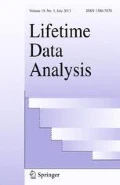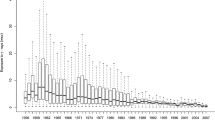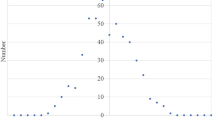Abstract
This paper considers the analysis of time to event data in the presence of collinearity between covariates. In linear and logistic regression models, the ridge regression estimator has been applied as an alternative to the maximum likelihood estimator in the presence of collinearity. The advantage of the ridge regression estimator over the usual maximum likelihood estimator is that the former often has a smaller total mean square error and is thus more precise. In this paper, we generalized this approach for addressing collinearity to the Cox proportional hazards model. Simulation studies were conducted to evaluate the performance of the ridge regression estimator. Our approach was motivated by an occupational radiation study conducted at Oak Ridge National Laboratory to evaluate health risks associated with occupational radiation exposure in which the exposure tends to be correlated with possible confounders such as years of exposure and attained age. We applied the proposed methods to this study to evaluate the association of radiation exposure with all-cause mortality.
Similar content being viewed by others
References
Barker L and Brown C (2001). Logistic regression when binary predictor variables are highly correlated. Stat Med 20: 1431–1442
Cardis E, Gilbert E and Carpenter L (1995). Effects of low doses and low dose rates of external ionizing radiation: cancer mortality among nuclear industry workers in three countries. Radiat Res 142: 117–132
Cardis E, Vrijheid M, Blettner M, Gilbert E, Hakama M, Hill C, Howe G, Kaldor J, Muirhead CR, Schubauer-Berigan M., Yoshimura T., Bermann F, Cowper G, Fix J and Hacker C (2005). Risk of cancer after low doses of ionizing radiation–retrospective cohort study in 15 countries. Br Med J 331: 77–81
Crivelli A, Firinguetti L, Montano R and Munoz M (1995). Confidence intervals in ridge regression by bootstrapping the dependent variable: a simulation study. Commun Statist Simula 24: 631–652
Cox DR (1972). Regression models and life tables (with discussion). J Royal Stat Soc Series B 34: 187–220
Efron B, Tibshirani R (1993) An introduction to the bootstrap. Chapman & Hall
Frome EL, Cragle DL, Watkins JP, Wing S, Shy CM, Tankersley WG and West CM (1997). A mortality study of employees of the nuclear industry in oak ridge, tennessee. Radiat Res 148: 64–80
Gibbons DG (1981). A simulation study of some ridge estimators. J Am Stat Assoc 76: 131–139
Gilbert ES (1989). Issues in analyzing the effects of occupational exposure to low levels of radiation. Stat Med 8: 173–187
Gilbert ES, Omohundro E, Buchanan J and Holter N (1993a). Mortality of workers at the hanford site: 1945-1986. Health Phy 64: 577–590
Gilbert ES, Cragle D and Wiggs L (1993b). Updated analyses of combined mortality data for workers at the hanford site, oak ridge national laboratory, and rocky flats weapons plant. Radiat Res 136: 408–421
Huang J and Harrington D (2002). Penalized partial likelihood regression for right censored data with bootstrap selection of the penalty parameter. Biometrics 58: 781–791
Hoerl AE and Kennard RW (1970a). Ridge regression: biased estimation for nonorthogonal problems. Technometrics 12: 55–67
Hoerl AE and Kennard RW (1970b). Ridge regression: some simulations. Commun Stat 4(2): 1105–1123
Holford TR, Zheng T, Mayne S, Zahm SH, Tessari JD and Boyle P (2000). Joint effects of nine polychlorinated biphenyl (PCB) congeners on breast cancer risk. Int J Epidemiol 29: 975–982
Lagakos SW (1988). Effects of mismodelling and mismeasuring explanatory variables on tests of their association with a response variable. Stat Med 7: 257–274
Lustbader ED (1986). Relative risk regression diagnosis. In: Moolgavkar, SH and Prentice, RL (eds) Modern statistical methods in chronic disease epidemiology, pp. SIAM, Philadelphia
Marsh JL, Hutton JL and Binks K (2002). Removal of radiation dose response effects: an example of over-matching. Brit. Med. J 325: 327–330
Schafer RL, Roi LD and Wolfe RA (1984). A ridge logistic estimator. Commun Stat Theory Methods 13(1): 99–113
Smith KR, Slattery ML and French TK (1991). Collinear nutrients and the risk of colon cancer. J Clin Epidemiol 44: 715–723
Shore RE (1990). Occupational radiation studies: status, problems and prospects. Health Phys 59: 63–68
Tibshirani R (1996). Regression shrinkage and selection via the lasso. J Royal Stat Soc Series B 58: 267–288
Tibshirani R (1997). The lasso method for variable selection in the cox model. Stat Med 16: 385–395
Van Houwelingen JC (2001). Shrinkage and penalized likelihood as methods to improve predictive accuracy. Stat Neerlandica 55: 17–34
Verweij PJM and van Houwelingen HC (1994). Penalized likelihood in cox regression. Stat Med 13: 2427–2436
Verweij PJM and van Houwelingen HC (1993). Cross-validation in survival analysis. Stat Med 12: 2305–2314
Wing S, Shy CM, Wood JL, Wolf S, Cragle DL and Frome EL (1991). Mortality among workers at oak ridge national laboratory, evidence of radiation effects in follow-up through 1984. J Am Med Assoc 265: 1397–1402
Wing S, Shy CM, Wood JL, Wolf S, Cragle DL, Tankersley W and Frome EL (1993). Job factors, radiation and cancer mortality at oak ridge national laboratory: follow up through 1984. Am J Indust Med 23: 265–279
Wing S and Richardson DB (1999). Greater sensitivity to ionizing radiation at older age: follow-up of workers at oak ridge national laboratory through 1990. Int J Epidemiol 28: 428–436
Xue X, Shore RE, Ye X and Kim MY (2004). Estimating the dose response relationship for occupational radiation exposure measured with minimum detection level. Health Phys 87: 397–404
Author information
Authors and Affiliations
Corresponding author
Rights and permissions
About this article
Cite this article
Xue, X., Kim, M.Y. & Shore, R.E. Cox regression analysis in presence of collinearity: an application to assessment of health risks associated with occupational radiation exposure. Lifetime Data Anal 13, 333–350 (2007). https://doi.org/10.1007/s10985-007-9045-1
Received:
Accepted:
Published:
Issue Date:
DOI: https://doi.org/10.1007/s10985-007-9045-1




